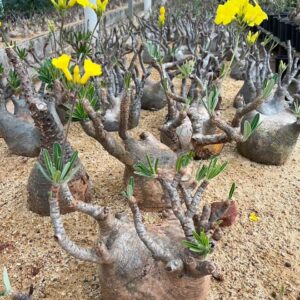is a unique and fascinating plant species within the Euphorbiaceae family. Here’s an overview of its characteristics, habitat, and care requirements:
-
: It is a densely branched, hemispherical, succulent-stemmed shrub that can grow up to 60 cm (occasionally up to 100 cm) in height. The stems are thick and branching, with spines arranged in rows.
-
: The leaves are sessile or short-petioled, crowded at the tips of the stems, and are deciduous.
-
: The plant produces yellowish-green or sometimes red bracts that encase the cyathia. The actual flowers (cyathia) are small and hairy.
-
: Euphorbia guillauminiana is endemic to Madagascar, specifically found in rocky areas and dry scrublands.
-
: It thrives in well-drained soil with limited water and full sun2.
-
: Requires bright, indirect light with daytime temperatures between 21°C to 29°C (70°F to 85°F) and nighttime temperatures around 15°C (60°F).
-
: Maintain humidity levels between 40-60% to prevent mold or shriveled buds.
-
: Sensitive to overwatering; ensure well-draining soil and avoid watering during dormancy.
-
: Difficult to cultivate; best propagated by continuously growing new seedlings.
-
: Threatened by habitat degradation, human activity, and illegal collection for horticulture.
Overall, Euphorbia guillauminiana is a challenging yet rewarding plant for experienced growers due to its specific care requirements and conservation status.
how to cultivate Euphorbia guillauminiana
To cultivate Euphorbia guillauminiana, follow these detailed guidelines:
1.
-
Provide full sun exposure with at least 6 hours of direct sunlight daily. Indoors, place the plant near a south-facing window or use a grow light designed for succulents.
2.
-
Use well-draining soil to prevent waterlogging and root rot. A mix of potting soil, sand, and perlite is ideal, or opt for a commercial succulent soil mix.
-
Ensure the pot has drainage holes to avoid excess moisture retention.
3.
-
During the growing season (spring to fall), allow the top 2 inches of soil to dry out completely between waterings (typically every 7–10 days). Reduce watering significantly during winter dormancy, only watering when the plant shows signs of shriveling.
-
Water in the morning to ensure any moisture on the plant evaporates during the day.
4.
-
Maintain temperatures between 21–29°C (70–85°F) during the day and around 15°C (60°F) at night.
-
Humidity levels should be moderate (40–60%).
5.
-
Feed with a diluted, balanced succulent fertilizer during the growing season, once a month or as needed. Avoid fertilizing during dormancy.
6.
-
: Take healthy cuttings, allow them to callus over for a few days, and plant in well-draining soil. Water sparingly until roots develop.
-
: Sow seeds in a well-draining seed mix in spring. Keep the soil moist but not soggy and provide bright, indirect light. Germination may take 2–6 months.
7.
-
Avoid overwatering, as Euphorbia guillauminiana is prone to root rot.
-
Regularly inspect for pests like mealybugs or spider mites.
-
Repot only when necessary, such as when the plant outgrows its container.
By meeting these requirements, you can successfully cultivate this unique and sculptural succulent.
What type of soil is most suitable for Euphorbia guillauminiana
The most suitable soil for Euphorbia guillauminiana is a well-draining, sandy, and loamy mix with good aeration. This type of soil prevents water retention and reduces the risk of root rot. You can create an ideal mix by combining equal parts of regular potting soil, sand, and perlite or by using a commercial cactus or succulent potting mix.
-
: Excellent drainage is essential to avoid waterlogging.
-
: Slightly acidic to neutral (6.5 to 7.5) is optimal.
-
: Adding organic matter like compost can improve fertility and structure.
-
: Light and airy to allow proper root aeration.
By ensuring these conditions, Euphorbia guillauminiana can thrive in both pots and outdoor gardens.





Reviews
There are no reviews yet.